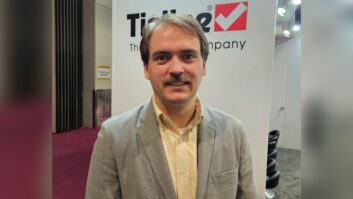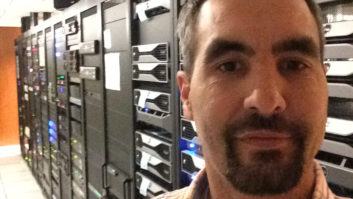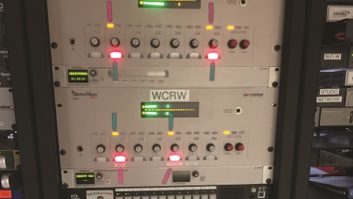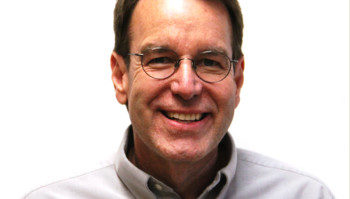In the Coming Years, the ISM Band May Well Become a De Facto Broadcast Auxiliary Band
For many years, competition for the limited number of STL frequencies has been an issue in and around the bigger cities. Crowding in the STL bands became even more of a problem 25 or so years ago when broadband composite links became popular.
(click thumbnail)Harris Aurora 5800
Consolidation added to the problem, and antenna farms – efficient in many ways but presenting challenges with respect to STL frequency usage and RF radiation – brought their own set of issues. Digital and hybrid digital/analog links, while efficient users of spectrum by multiplexing many audio channels onto one link, still soak up a good bit of bandwidth, equal to that of composite links in many cases.
SBE coordinators have, over the years, done a tremendous job of keeping radio stations out of each other’s way on the STL bands, but there has been only so much they could do. With only 13 possible 500 kHz channels in the 944 to 952 MHz Broadcast Auxiliary band, the options have always been limited.
5.8 GHz This sort of thing has sent broadcast engineers scrambling for alternatives.
(click thumbnail)The Motorola Canopy cluster, including NEMA enclosure, was installed on KLZ’s east tower.
Today, in addition to over-the-air STL links, radio stations are taking advantage of all sorts of technology to deliver the goods to their transmitter sites. They are using T1, ISDN, even DSL in some cases. A few still rely on leased analog equalized telco lines (“broadcast loops”). Now, with PCN coordination required on all fixed Broadcast Auxiliary applications (which can cost upwards of $1,000), there is even more incentive to find alternatives to traditional 950 MHz STL links. A couple of years ago, Crawford added a new class C FM station to our established Birmingham, Ala., cluster. This station had a transmitter site well north of the city, and the current owner was using a two-hop 950 MHz STL to feed the site.
We had no desire to continue that arrangement, primarily because it required a monthly lease for the relay site, which was remote and for a number of reasons, added another point of failure to the overall equation. We already had a tall tower on Birmingham’s Red Mountain with a clear line of sight to the new station’s transmitter site, but Red Mountain is an antenna farm, with numerous FM stations operating from the top. It became clear that getting another 950 MHz signal from the city up to that site without causing or receiving interference would be, well, impossible. We had to find another way. That was when we began looking at unlicensed digital spread spectrum in the 5.8 GHz ISM band.
This band has a lot to offer. Low transmitter powers through small, high-gain antennas produce small-beamwidth transmissions that are unlikely to receive interference from co- and adjacent-channel users. In addition, the packetized, error-corrected nature of the transmissions carries a high immunity from even on-channel interference.
(click thumbnail)The Canopy helped Crawford solve a problem in Denver. The backhaul module with reflector is shown.,
The whole architecture is designed to allow many users in a given geographic area to share a frequency, and the transmissions are bi-directional.
Aurora In Birmingham, we chose the Harris Aurora 5800, from the company’s microwave division. It provides, in essence, a bi-directional T1 link between two line-of-sight locations up to 30 miles apart. T1 was nothing new to us; Crawford has been using T1 for STL applications around Birmingham for many years. The thing is, T1 terminal equipment can be expensive. We wanted to avoid having to purchase an Intraplex or QEI CAT-Link in addition to the Aurora. That led us to our friends at Moseley Associates. Most broadcasters these days are familiar with the DSP6000 digital encoder/decoder system. This hardware, when connected to a composite 950 MHz STL, can provide a hybrid digital STL system carrying two or four channels of audio plus an auxiliary data channel.
When Moseley created the DSP6000, it included a feature that would allow it to operate over a fractional T1 in addition to a composite STL. It was this fractional T1 capability, in addition to relatively low cost, that made the DSP6000 attractive to us in this application. To make the DSP6000 work with the Aurora, we had to purchase an inexpensive Adtran CSU (channel service unit) for each end. Moseley was a big help, assisting us with the proper cabling between the Aurora, the CSU and the DSP6000. The end result was a four-channel audio link with a data channel from our Birmingham studios and our Red Mountain transmitter site.
Two of the audio channels feed a 950 MHz digital STL link to the new FM station’s transmitter site some 50 miles north of the city; the other two feed one of our AM stations via a different 950 MHz digital link. The trick was getting the feeds for the two stations to the Red Mountain site. This ISM-band link has been 100 percent reliable since we installed it. We experienced no dropouts even through a couple of tropical storms that produced rainfall so intense that one could drown standing up in the parking lot.
Under the Canopy Last year in Denver, we were looking for ways to cut operating costs. With our Denver cluster’s studio located in a historical district near downtown, over-the-air 950 MHz STLs have always been out of the question.
We have fed each of our four transmitter sites with T1 circuits since day one. These T1s have been expensive and somewhat less than reliable. Each site has an ISDN backup, which gets us through the T1 failures (except in the case of “backhoe fade,” which, thankfully, hasn’t happened). We briefly considered the Aurora in Denver, but about that time another station in town began using a different product, the Motorola Canopy. This is really a wireless broadband platform, meant to be used by wireless Internet providers. It consists of access points (used to “broadcast” to subscribers), subscriber modules (used at subscriber locations), and backhaul units (used for site-to-site links in the wireless network).
It was the backhaul units that initially caught our eye. These units mate a 60-degree transceiver/antenna with a reflector (dish) to provide a point-to-point link over up to 35 miles with a 1.8-degree beamwidth at 5.8 GHz. Unlike the Aurora, which provides a 1.544 Mbps T1 link, the Canopy provides a 10/100BaseT connection between sites with 10 Mbps bandwidth. In addition, by using access point and subscriber modules, we could get around isocoupling from our hot AM towers. All we had to do was provide continuous 110-volt AC power on the towers (already there for tower lights via Austin Ring transformers).
The transmitter end of the backhaul modules would connect to an access point that would in turn connect to a subscriber module a few hundred feet away on the transmitter building. The base insulator would be crossed with 5.8 GHz RF, and that would have no effect whatsoever on the tower impedance or current distribution. That left us with the question of how to get audio into and out of the Canopy. The other Denver station that was using the system used an audio streaming encoder on a PC for this purpose. That is certainly an economical way to get the job done, but I was uncomfortable with a PC in the air chain. That was when we found out about a new Harris product, the CM-20 TCP/IP module for the Intraplex. This new module would allow the Intraplex to operate point-to-point over any TCP/IP connection, even the Internet.
No lines It took a bit of experimenting to get things just right, but Ed Dulaney and our Denver engineering crew were successful. We have been running for the better part of a year now on Canopy in parts of our Denver cluster.
Between the studio and our critical KLZ(AM) transmitter site, which is a hub of sorts for our entire operation, we run four channels of audio outbound and eight on the return. Outbound, we feed not only KLZ on-air audio but also audio to our corporate satellite channel (the uplink is located at the KLZ transmitter site). The return feeds multiple channels of satellite audio and air monitor back to the studio. For redundancy, we ran a completely separate link to KLZ via the second tower at the KLZ transmitter site. It is identical in every respect to the first link, consisting of a backhaul link from the studio, a backhaul module and access point on the second KLZ tower and a second subscriber module on the roof of the KLZ transmitter building. Should lightning wipe out any part of one system, the other system should be ready to take over. We kept the ISDN backup as well, giving us a place to go for last-ditch emergency situations and for system maintenance. One great thing about the Canopy system is that there are no transmission lines. Shielded CAT-5 cable is used to feed the self-contained “transceiver-antenna” modules. The backhauls, access points and subscriber modules all look alike and are about the size of a paperback. A “wall wart” power supply is used to insert power on the CAT-5 through an RFI filter/surge suppressor. For our on-tower installations, our Denver crew built up weatherproof NEMA electrical enclosures that contain additional surge/RFI suppression and electrical outlets for the power supplies. The NEMA boxes are mounted outside the tower structure within a few feet of the Canopy cluster to keep lightning surges from inducing damaging voltages in long runs of CAT-5. So far, we have made it through one thunderstorm season without damage or outage. The cost? Excluding the Intraplex equipment, the over-the-air portion is about half that of a typical over-the-air 950 MHz STL. Include the Intraplex, and depending on the configuration, the cost is about twice that of a hybrid 950 MHz over-the-air system.
Net access
There are other benefits, we found, to having a 10/100BaseT connection between our studios and transmitter sites. One is that we now have high-speed Internet access at our transmitter sites. Two is that we can use excess capacity for all sorts of other things.
Broadcast Tools, for example, makes a device that connects over TCP/IP that gives you 32 contact closures on each end. Close a contact on one end and the counterpart on the other end also closes. There is little latency with this device over the Canopy, so operation appears instantaneous. We use this device to transmit satellite contact closures back to the studio.
Another device manufactured by Digi and distributed by BT provides a point-to-point RS-232 connection over TCP/IP. With that little goodie, you can connect your remote control or other serial device.
For security, we have installed Webcams that we can monitor from anywhere over the Internet. The one at KLZ is aimed at the transmitters and equipment racks. Should an off-air condition occur, our engineers can look and see what transmitter fault lights are on. If the room is full of smoke, they can call the fire department! I’m sure there are a number of other digital spread spectrum systems out there that will work equally as well as Aurora and Canopy. At the spring NAB convention, Broadcast Electronics introduced the “Big Pipe,” a 5.3 GHz bidirectional STL that provides up to 45 Mbps of bandwidth. Others are sure to follow. As consolidation continues along with allocation shuffles and market move-ins, finding creative, cost-effective means of delivering the goods to our transmitter sites will undoubtedly become one of the most challenging aspects of the radio engineer’s job.
In the coming years, the ISM band may well become a de facto broadcast auxiliary band. Tell us about your own novel solution to a technical problem at [email protected]










